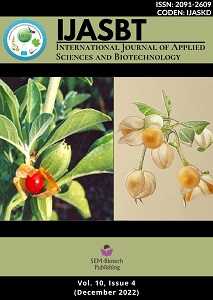Biofertilizer reduces the dependency on chemical fertilizer on wheat production
DOI:
https://doi.org/10.3126/ijasbt.v10i4.49857Keywords:
Biofertilizer, Chemical fertilizer, Seed application, Soil application, Spring wheat, Biofertilizer, Chemical fertilizer, Seed application, Spring wheatAbstract
Scarce availability of chemical fertilizers threatens sustainability of wheat production in Nepal. Combined application of chemical and biofertilizer can reduce chemical fertilizer and enhance the yield under limited fertilizer availability. A field experiment was carried out to assess the combined application of chemical and biofertilizer on the growth and yield of spring wheat at Rampur, Chitwan from November 2020 to April 2021. The experiment was laid out in strip plot design with four nitrogen and P2O5 levels (0, 50, 75 and 100% of recommended dose) in vertical plots and three biofertilizer application methods (not applied, seed applied and soil applied) in horizontal plots with three replications. The research results revealed significant interaction between nitrogen and P2O5 levels and biofertilizer application methods. The highest grain yield (4624.48 kg ha-1) of wheat was obtained with 100% levels of N and P2O5 with soil applied biofertilizer at par with 75% levels of N and P2O5 with soil applied biofertilizer (4457.54 kg ha-1). The total nitrogen uptake was higher in biofertilizer applied wheat as compared with no application of biofertilizer although statistically not significant. The yield increment in 100% and 75% N and P2O5 levels with soil applied biofertilizer over same level N and P2O5 with no biofertilizer application were 10.96% and 29.60% respectively. The higher gross return, net return and B:C ratio were obtained with 75% and 100% N and P2O5 levels with soil and seed applied biofertilizers. The result indicates that 25% recommended dose of N and P2O5 could be reduced by soil application of biofertilizer without compromising the grain yield of wheat.
Int. J. Appl. Sci. Biotechnol. Vol 10(4): 245-253.
Downloads
Downloads
Published
How to Cite
Issue
Section
License
Copyright (c) 2022 International Journal of Applied Sciences and Biotechnology

This work is licensed under a Creative Commons Attribution-NonCommercial 4.0 International License.




